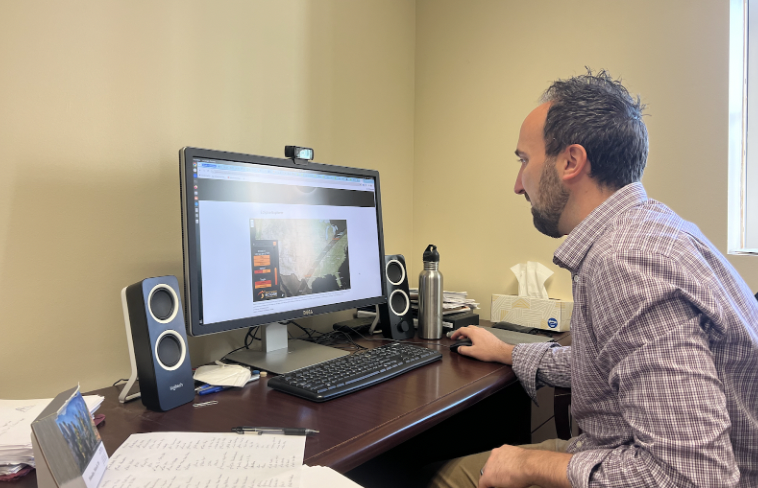By Jesse Carr
Codey Marshall paced the SMU hallway nervously. He wasn’t on a combat patrol through the streets of Baghdad anymore; he was transitioning into his first day at a four-year university. Used to doing everything with his fellow Marines, Marshall found himself alone in a sea of students. Although SMU’s campus lacked the chaos and danger that he was conditioned for, Marshall was still nervous and excited.
“When you leave active duty your world changes completely, the support network goes away,” said Marshall, an undergraduate student studying markets and culture at SMU and the incoming Vice-President for SMU MilVets. Marshall served in the Marine Corps from 2002-2006 as an infantry assaultman, deploying twice to Iraq.
Combat is starkly different then the classroom, but for some veterans like Marshall, adjusting to the classroom environment can be more intimidating than being deployed in combat.
This semester SMU has 124 student veterans utilizing tuition benefits and taking advantage of SMU’s Yellow Ribbon Program. However, research suggests that before graduating more than half of those veterans will drop out.
In 2012, The Huffington Post claimed that a staggering 88 percent of veterans drop out of college. Since 2010 there have been two studies conducted on veterans and college. However, both studies were conducted less than 10 years since the start of the wars in Iraq and Afghanistan. After the completion of these studies, many experts began comparing post 9/11 veterans to post WWII, Korea, and Vietnam veterans. Experts claimed that veterans of the wars in Iraq and Afghanistan faced a much higher dropout rate.
Matt Macleod, a Marine Corps veteran with two deployments to Afghanistan, believes that the numbers are skewed.
“I don’t think the studies are accurate because I think there are a high number of veterans who start college without really any intention of graduating,” said Macleod.
Some veterans have to drop out because of family responsibilities, while others are forced to drop out due to financial difficulties because of reduction in tuition benefits.
“I love the people at the VA,” said Robert Nelson, incoming president for SMU MilVets, “But the system is so complicated and confusing that it’s nearly impossible to get in touch with the person that can help you.”
Nelson served in the Air Force and is an undergraduate student studying economics.
Since the fall of 2012, SMU has had 722 veterans enrolled with 157 of those enrolled graduating. While that number isn’t an accurate reflection of the graduation rate, school officials were unable to provide an exact graduation rate, but claim that it is very high.
“I’m here because I want to be. SMU is the highest ranked school in Dallas. This is our life, we aren’t here just because. We’re here because we need it, because we want it, and because we love it,” said Marshall.
Chris Cate, vice-president of research for Student Veterans of America, published two papers in response to the surveys of veterans and the claim that the dropout rate is 88 percent.
He believes that, “national data on student veterans is difficult to find, simply because no federal department has been tasked with the collection and analysis of data regarding student veterans or their academic outcomes. This is a problem for policy makers and stakeholders who rely on research to make informed decisions.”
While the number of veterans at SMU is relatively low in comparison with cross-town rival TCU, Nelson appreciates that veterans on campus aren’t just a number at SMU.
“SMU will go out of their way to support us. Even in the classroom professors are willing to give us the benefit of the doubt; whether it’s with missing class because of an appointment with the VA, or turning in an assignment late because one of our kids is sick,” said Nelson.
The simple fact is that not enough time has passed since the end of the wars in Iraq and Afghanistan for studies to accurately reflect veteran dropout rates, but until that time comes, veterans will be fighting the stigma of an 88 percent dropout rate.
Hannah Wood, the outgoing president of SMU MilVets and a Navy veteran. will be graduating this May from SMU with a bachelor’s degree in anthropology and Russian.
“Transitioning into the classroom is hard for veterans of all branches, for those who have families it is even harder, however the things I learned in the military definitely helped that transition,” Wood said.
Wood cites discipline and work ethic that she learned in the Navy as two things that played a key role in her transition from military life to the classroom. For Marshall, competition played a role in his transition.
“I had to adjust to the competition, but it was definitely motivating,” said Marshall, “As a Marine I’m more of an alpha male type, and in the Marine Corps we are taught to feed off of competition.”
On any afternoon during the week the veteran’s lounge on the third floor of the Hughes-Trigg Student Center will be filled with veterans. Although it is small, for SMU veterans it is a safe place to go, a place where they can speak in military lingo and be understood, a place where they can laugh and tell jokes, and most importantly a place filled with peers who understand their struggles.
“We have veterans who spend hours in here,” said Nelson. “I walk in here and find them asleep on the couch. This is our sanctuary, we love it and we are extremely grateful that we have it.”
At the end of the day, veterans at SMU are appreciative and thankful for how supportive the university is.
“It would be nice if we had a bigger veteran’s center on campus with a VA representative and a couple advisors specifically for veterans, but I think those things will come with time,” said Wood.
While veterans at SMU won’t quickly admit that the transition is hard, they will admit that it takes some time getting used to. But with a university that goes out of its way to support them, and a safe haven on campus in the veterans lounge, veterans at SMU are prepared and motivated to prove the numbers wrong.
“We aren’t victims,” said Marshall. “We are proud of our military service, and we appreciate the respect we are show as veterans, but we are here to earn an education just like all the other students.”













